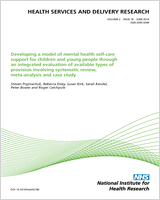Included under terms of UK Non-commercial Government License.
NCBI Bookshelf. A service of the National Library of Medicine, National Institutes of Health.
Senior J, Forsyth K, Walsh E, et al. Health and social care services for older male adults in prison: the identification of current service provision and piloting of an assessment and care planning model. Southampton (UK): NIHR Journals Library; 2013 Aug. (Health Services and Delivery Research, No. 1.5.)

Health and social care services for older male adults in prison: the identification of current service provision and piloting of an assessment and care planning model.
Show detailsKey objective: investigate integration between health, prison and social care services.
Introduction
- 1.1 Could you tell me a little bit about your role?
- 1.2 What specific duties/involvement do you have regarding/with older offenders?
- 1.3 Are these official or unofficial duties?
Entry into prison
- 2.1 Who gathers information regarding older offenders?
- 2.2 When is this information collected?
- 2.3 What information do you receive about older offenders?
- 2.4 Do you get the information you need? Too much information? Irrelevant information?
- 2.5 Are there problems with obtaining information?
- 2.6 What happens to the information gathered at the assessment/induction phase?
Joined-up working within the prison
- 3.1 Do you have a lead for older offenders within the establishment?
- 3.2 Is this a prison or health care member of staff, or is there one in each department?
- 3.3 Does the lead/leads link in with other departments in the prison and with outside agencies? If so, in what ways?
- 3.4 What inhibits/facilitates this liaison function?
- 3.5 Is there anything that could be improved concerning this role?
- 3.6 If no older lead present, are you aware of such a role?
- 3.7 Do you think there is a need to have such a role?
- 3.8 In what ways do you and your colleagues work with other departments to support older offenders?
- 3.9 What facilitates this joined-up working?
- 3.10 What blocks such work?
- 3.11 How could this be improved?
Communication/information sharing
- 4.1 How do you share information between departments within the prison? Make referrals? Seek advice? Written means, informal meetings?
- 4.2 How appropriate are these systems of communication? How could they be improved? Quantity of information received?
Internal staff working with external agencies
- 5.1 What services do you link up with to support older offenders?
- 5.2 What services do you think need to be involved with older offenders?
- 5.3 What assists joined-up working?
- 5.4 What are the barriers to joined-up working?
- 5.5 What aspects of joined-up working could be improved?
- 5.6 Are there any other services available that you think should be involved?
- 5.7 How do you and your colleagues communicate with external agencies? To make referrals? In seeking advice?
- 5.8 What are the problems you face working with external agencies?
- 5.9 What would be a way of improving the communication/information gathering/referral process?
Discharge from prison/support in the community
- 6.1 What is your role in the release of an ‘older’ offender?
- 6.2 How far in advance does this take place?
- 6.3 When is the offender notified about this process?
- 6.4 How do you work with external agencies to support the release of ‘older’ offenders?
- 6.5 What departments work with agencies to support the release of an older offender?
- 6.6 What works well during this?
- 6.7 How could this be improved?
- 6.8 What communication takes place between you, your colleagues and external agencies involved in the release of ‘older’ offenders?
- 6.9 What works well in this process?
- 6.10 What doesn't work well in this process?
Summary
- 7.1 What ways do you feel your establishment is successful in supporting ‘older’ offenders?
- 7.2 How does your establishment support joined-up working between departments?
- 7.3 How does your establishment support collaborative working with other agencies/services?
- 7.4 What ways do you feel your establishment is successful at exchanging information?
- 7.5 What are the barriers to appropriately supporting ‘older’ offenders?
- 7.6 Is there anything else you would like to add about health and social care services for ‘older’ offenders at this establishment?
- Staff interview guide - Health and social care services for older male adults in...Staff interview guide - Health and social care services for older male adults in prison: the identification of current service provision and piloting of an assessment and care planning model
Your browsing activity is empty.
Activity recording is turned off.
See more...